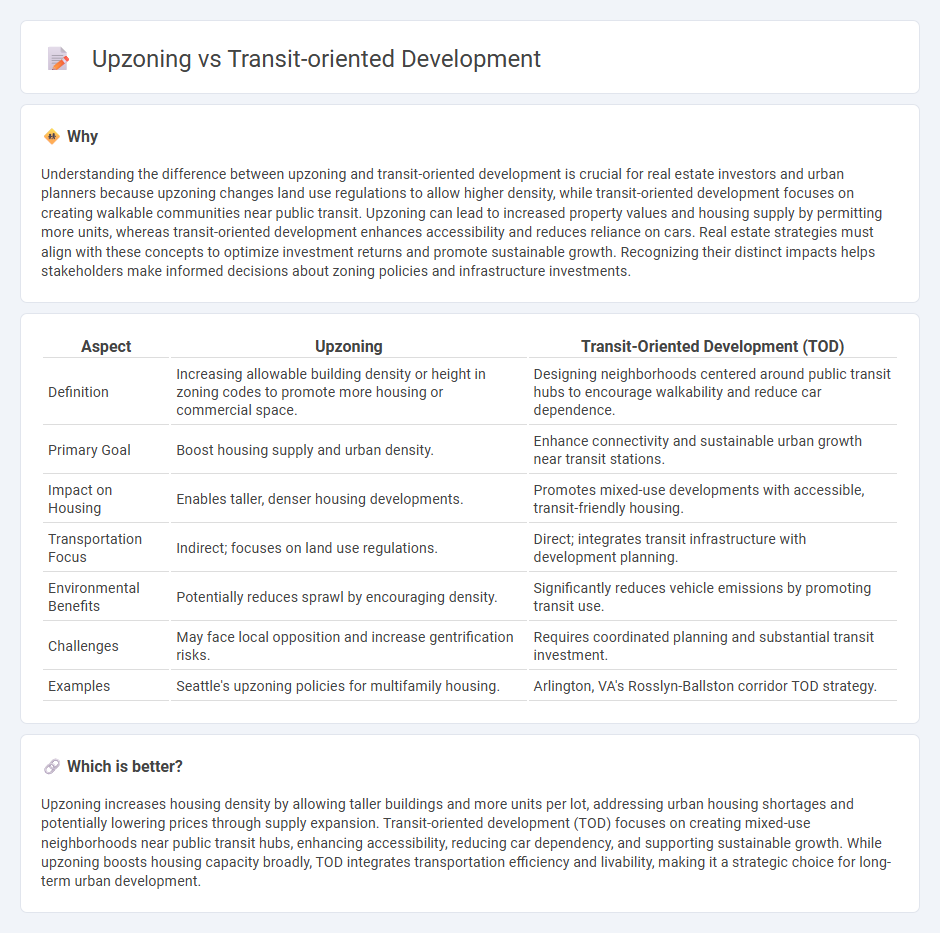
Upzoning increases allowable building density, enabling more residential or commercial units in a given area to address housing shortages and boost urban growth. Transit-oriented development (TOD) focuses on creating vibrant, walkable communities centered around public transportation hubs, reducing reliance on cars and promoting sustainability. Explore how upzoning and TOD reshape modern real estate markets and urban living.
Why it is important
Understanding the difference between upzoning and transit-oriented development is crucial for real estate investors and urban planners because upzoning changes land use regulations to allow higher density, while transit-oriented development focuses on creating walkable communities near public transit. Upzoning can lead to increased property values and housing supply by permitting more units, whereas transit-oriented development enhances accessibility and reduces reliance on cars. Real estate strategies must align with these concepts to optimize investment returns and promote sustainable growth. Recognizing their distinct impacts helps stakeholders make informed decisions about zoning policies and infrastructure investments.
Comparison Table
| Aspect | Upzoning | Transit-Oriented Development (TOD) |
|---|---|---|
| Definition | Increasing allowable building density or height in zoning codes to promote more housing or commercial space. | Designing neighborhoods centered around public transit hubs to encourage walkability and reduce car dependence. |
| Primary Goal | Boost housing supply and urban density. | Enhance connectivity and sustainable urban growth near transit stations. |
| Impact on Housing | Enables taller, denser housing developments. | Promotes mixed-use developments with accessible, transit-friendly housing. |
| Transportation Focus | Indirect; focuses on land use regulations. | Direct; integrates transit infrastructure with development planning. |
| Environmental Benefits | Potentially reduces sprawl by encouraging density. | Significantly reduces vehicle emissions by promoting transit use. |
| Challenges | May face local opposition and increase gentrification risks. | Requires coordinated planning and substantial transit investment. |
| Examples | Seattle's upzoning policies for multifamily housing. | Arlington, VA's Rosslyn-Ballston corridor TOD strategy. |
Which is better?
Upzoning increases housing density by allowing taller buildings and more units per lot, addressing urban housing shortages and potentially lowering prices through supply expansion. Transit-oriented development (TOD) focuses on creating mixed-use neighborhoods near public transit hubs, enhancing accessibility, reducing car dependency, and supporting sustainable growth. While upzoning boosts housing capacity broadly, TOD integrates transportation efficiency and livability, making it a strategic choice for long-term urban development.
Connection
Upzoning increases allowable building density near transit hubs, enabling transit-oriented development (TOD) to maximize land use efficiency and improve access to public transportation. This connection promotes walkable neighborhoods, reduces reliance on cars, and supports sustainable urban growth. Cities implementing upzoning policies near transit corridors often experience increased affordable housing options and enhanced economic activity.
Key Terms
**Transit-Oriented Development:**
Transit-Oriented Development (TOD) prioritizes creating walkable, mixed-use communities centered around high-quality public transit hubs, reducing reliance on private vehicles and promoting sustainable urban growth. This approach integrates residential, commercial, and recreational spaces within a compact radius of transit stations to enhance accessibility and improve quality of life. Explore the benefits and implementation strategies of TOD to understand its impact on urban planning and environmental sustainability.
Mixed-use development
Transit-oriented development (TOD) integrates mixed-use development within walkable distances of public transit hubs, fostering higher density living, retail, and office spaces that reduce car dependency and promote sustainable urban growth. Upzoning permits increased building heights and densities, primarily aiming to encourage mixed-use development by easing zoning restrictions for residential, commercial, and retail uses in targeted areas. Explore how combining TOD and upzoning strategies can maximize mixed-use development benefits for vibrant, accessible cities.
Walkability
Transit-oriented development (TOD) emphasizes creating high-density, mixed-use neighborhoods within walking distance of public transit hubs to enhance walkability and reduce car dependency. Upzoning often increases allowable building heights and densities, which can support walkability but may not include integrated transit access or pedestrian-friendly design by default. Explore how combining TOD principles with strategic upzoning can maximize walkable urban environments.
Source and External Links
Transforming the Urban Space Through Transit-Oriented Development - Transit-oriented development (TOD) is a strategy that promotes compact, mixed-use urban development with jobs, housing, and services clustered around public transport stations to boost economic growth, livability, and transit viability.
Transit-Oriented Development | FTA - TOD focuses on creating dense, walkable, mixed-use communities near transit to enhance neighborhood revitalization, affordable housing, economic returns, transit ridership, and environmental benefits.
Transit-Oriented Development - TOD maximizes residential, commercial, and activity space near transit, with policies supporting increased densities, affordable housing, flexible design, and integration within community visions, as exemplified by Washington State's 2025 legislation.
 dowidth.com
dowidth.com